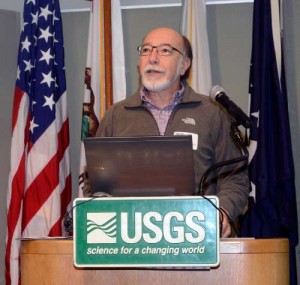Frequent Small Earthquakes Raise Risk of Bigger Ones in Oklahoma, Study Suggests
-
Joe Wertz

Michael Diggles / U.S. Geological Survey
USGS geophysicist William Ellsworth.
The daily occurrence of small earthquakes linked to oil and gas drilling in Oklahoma increases the likelihood of larger earthquakes, new research suggests.
“The chances are still small, but we know that from earthquakes the real potential for trouble is in those very unlikely large-magnitude earthquakes,” says geophysicist William Ellsworth of the U.S. Geological Survey, who, along with state and university scientists, presented findings to the American Association for the Advancement of Science at the group’s annual conference in San Jose, Calif.
More earthquakes were recorded in Oklahoma than California in 2014, and scores of peer-reviewed scientific papers have linked at least some of the shaking to disposal wells used by the oil and gas industry. Evidence of so-called “induced earthquakes” has been found in other states, including Colorado, Ohio and Texas.
In Oklahoma and southern Kansas, the increase in earthquake activity means the region is “just as likely to see serious damaging and potentially harmful earthquakes as the highest risk places east of the Rockies such as New Madrid, Missouri, and Charleston, South Carolina, which had major quakes in the past two centuries,” scientists at the AAAS conference said, the Associated Press’ Seth Borenstein reports.
“When we’ve seen many small earthquakes, we know that there’s potential for large earthquakes to occur,” Ellsworth tells StateImpact. “That’s what’s really driving the current estimates of the hazard.”
The conference presentation served as a “status update” and followup to a three-day November 2014 meeting held in Oklahoma, where scientists, regulators and technical experts from the energy industry met to discuss the best ways to measure and map the hazards posed by manmade earthquakes.
Until recently, the National Seismic Hazard Maps were modeled after natural earthquake activity, but the USGS is working on an update that includes quakes that could be triggered by disposal wells, hydraulic fracturing or geothermal energy operations.
“What we’re trying to do is to develop a series of maps that describe the level of shaking that is rather unlikely, but is possible,” Ellsworth says. “This is the kind of information which is often used to make informed decisions about seismic safety.”
Earthquake hazard models are used by public safety planners, the construction and insurance industries and government agencies that oversee infrastructure like pipelines, roads, bridges and dams.
Ellsworth says Oklahoma is the scene for a lot of research into manmade quakes. In the short term, scientists are interested in how the ground-shaking from induced quakes compares to natural “tectonic quakes,” as well as getting a more complete understanding of Oklahoma’s fault systems so researchers can determine which faults are most vulnerable to slip from wastewater injection, Ellsworth says.
Long term research will likely focus on determining which disposal wells — or which combination of volume, pressure and well location — creates the biggest risk for triggering earthquakes.
Ellsworth says future policy decisions based on the science of manmade earthquakes are starkly different than those stemming from research of natural shaking.
“When earthquakes are being induced or triggered … by human activity, that’s something we can do something about,” he says.
